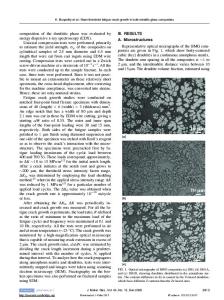Fatigue crack growth behavior of composites
- PDF / 1,150,065 Bytes
- 12 Pages / 598 x 778 pts Page_size
- 36 Downloads / 401 Views
I.
INTRODUCTION
IN the early 1960s, the continuous-reinforced boron fiber 6061 aluminum matrix composite system was developed for aerospace applications mainly to improve their specific stiffness property, t~JLater, during the 1970s, since boron fibers were expensive, cheaper carbon-reinforced metal matrix composites were introduced. Primarily, the main impetus for this was to have an alloy that gave high specific modulus and strength for high-temperature applications. Among the alloy systems considered were C-AI, A1203-A1 and AI203-Mg. tlJ In addition, during the same period, discontinuously reinforced (particles/ whiskers) metal matrix alloy development was introduced. These types of alloy developments were initiated to compete with the ingress of polymer-based composites, in which fairly large improvements in mechanical properties were being made. In metal matrix composites, while monotonic properties, such as strength and toughness, were improved by reinforcing a ductile matrix, the damage-tolerant properties, such as fracture toughness and fatigue crack growth, suffered significant degradation for most of the composites. These latter properties are important for component reliability and design, as they depend strongly on the alloy composition, fabrication methods, heat treatments, and environment (chemical or temperature). The degradation or improvement in these properties of composites, in turn, depends A.K. VASUDI~VAN is with the Office of Naval Research, Arlington, VA 22217. K. SADANANDA is with the Materials Science and Technology Division, Naval Research Laboratory, Washington, DC 20375. This article is based on a presentation made in the symposium entitled "Creep and Fatigue in Metal Matrix Composites" at the 1994 TMS/ASM Spring meeting, held February 28-March 3, 1994, in San Francisco, California, under the auspices of the Joint TMS-SMD/ASMMSD Composite Materials Committee. METALLURGICALAND MATERIALSTRANSACTIONSA
on (a) strength of the reinforcement, (b) strength of the interface, (c) degree of slip planarity, and (d) environmental sensitivity. Since the topical area is vast, we shall restrict our main discussions to fatigue crack growth resistance in discontinuously reinforced composites. Although most of the discussion pertains to metal matrix composites, since the available experimental support is limited for other systems, the concepts presented are general and are valid with some minor modifications for all matrix-reinforcement systems, including ductileductile, ductile-brittle, brittle-ductile, and brittle-brittle composites. The analysis will be primarily with the results pertaining to the threshold stress intensities and then extended to higher growth rates beyond the near-threshold crack growth. Recently, we have re-examined the fatigue threshold behavior in many different materials and concluded that the premature crack closure contributions are not significant enough to explain the overall trends in the data. We find that fatigue damage, in general, is a twoparametric problem, and the ove
Data Loading...











